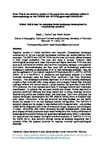Which DEM is best for analysing fluvial landscape development in mountainous terrains?
| dc.contributor.author | Boulton, Sarah | |
| dc.contributor.author | Stokes, M | |
| dc.date.accessioned | 2018-03-08T08:54:28Z | |
| dc.date.issued | 2018-06-01 | |
| dc.identifier.issn | 0169-555X | |
| dc.identifier.issn | 1872-695X | |
| dc.identifier.uri | http://hdl.handle.net/10026.1/11019 | |
| dc.description.abstract |
Regional studies of fluvial landforms and long-term (Quaternary) landscape development in remote mountain landscapes routinely use satellite-derived DEM data sets. The SRTM and ASTER DEMs are the most commonly utilised because of their longer availability, free cost, and ease of access. However, rapid technological developments mean that newer and higher resolution DEM data sets such as ALOS World 3D (AW3D) and TanDEM-X are being released to the scientific community. Geomorphologists are thus faced with an increasingly problematic challenge of selecting an appropriate DEM for their landscape analyses. Here, we test the application of four medium resolution DEM products (30 m = SRTM, ASTER, AW3D; 12 m = TanDEM-X) for qualitative and quantitative analysis of a fluvial mountain landscape using the Dades River catchment (High Atlas Mountains, Morocco). This landscape comprises significant DEM remote sensing challenges, notably a high mountain relief, steep slopes, and a deeply incised high sinuosity drainage network with narrow canyon/gorge reaches. Our goal was to see which DEM produced the most representative best fit drainage network and meaningful quantification. To achieve this, we used ArcGIS and Stream Profiler platforms to generate catchment hillshade and slope rasters and to extract drainage network, channel long profile and channel slope, and area data. TanDEM-X produces the clearest landscape representation but with channel routing errors in localised high relief areas. Thirty-metre DEMs are smoother and less detailed, but the AW3D shows the closest fit to the real drainage network configuration. The TanDEM-X elevation values are the closest to field-derived GPS measurements. Long profiles exhibit similar shapes but with minor differences in length, elevation, and the degree of noise/smoothing, with AW3D producing the best representation. Slope-area plots display similarly positioned slope-break knickpoints with modest differences in steepness and concavity indices, but again best represented by AW3D. Collectively, our study shows that despite the higher effective resolution of TanDEM-X (12 m), the AW3D (30 m) data performs strongly across all analyses suggesting that it currently offers the greatest potential for regional mountain geomorphological analyses. | |
| dc.format.extent | 168-168 | |
| dc.language | en | |
| dc.language.iso | en | |
| dc.publisher | Elsevier | |
| dc.rights | Attribution-NonCommercial-NoDerivatives 4.0 International | |
| dc.rights | Attribution-NonCommercial-NoDerivatives 4.0 International | |
| dc.rights | Attribution-NonCommercial-NoDerivatives 4.0 International | |
| dc.rights.uri | http://creativecommons.org/licenses/by-nc-nd/4.0/ | |
| dc.rights.uri | http://creativecommons.org/licenses/by-nc-nd/4.0/ | |
| dc.rights.uri | http://creativecommons.org/licenses/by-nc-nd/4.0/ | |
| dc.subject | Digital elevation model | |
| dc.subject | Digital surface model | |
| dc.subject | River profile | |
| dc.subject | Morocco | |
| dc.title | Which DEM is best for analysing fluvial landscape development in mountainous terrains? | |
| dc.type | journal-article | |
| dc.type | Journal Article | |
| plymouth.author-url | https://www.webofscience.com/api/gateway?GWVersion=2&SrcApp=PARTNER_APP&SrcAuth=LinksAMR&KeyUT=WOS:000435065000012&DestLinkType=FullRecord&DestApp=ALL_WOS&UsrCustomerID=11bb513d99f797142bcfeffcc58ea008 | |
| plymouth.volume | 310 | |
| plymouth.publication-status | Published | |
| plymouth.journal | Geomorphology | |
| dc.identifier.doi | 10.1016/j.geomorph.2018.03.002 | |
| plymouth.organisational-group | /Plymouth | |
| plymouth.organisational-group | /Plymouth/Faculty of Science and Engineering | |
| plymouth.organisational-group | /Plymouth/Faculty of Science and Engineering/School of Geography, Earth and Environmental Sciences | |
| plymouth.organisational-group | /Plymouth/REF 2021 Researchers by UoA | |
| plymouth.organisational-group | /Plymouth/REF 2021 Researchers by UoA/UoA07 Earth Systems and Environmental Sciences | |
| plymouth.organisational-group | /Plymouth/Research Groups | |
| plymouth.organisational-group | /Plymouth/Research Groups/Marine Institute | |
| plymouth.organisational-group | /Plymouth/Users by role | |
| plymouth.organisational-group | /Plymouth/Users by role/Academics | |
| dcterms.dateAccepted | 2018-03-04 | |
| dc.rights.embargodate | 2019-3-7 | |
| dc.identifier.eissn | 1872-695X | |
| dc.rights.embargoperiod | Not known | |
| rioxxterms.version | Accepted Manuscript | |
| rioxxterms.versionofrecord | 10.1016/j.geomorph.2018.03.002 | |
| rioxxterms.licenseref.uri | http://creativecommons.org/licenses/by-nc-nd/4.0/ | |
| rioxxterms.licenseref.startdate | 2018-06-01 | |
| rioxxterms.type | Journal Article/Review |



